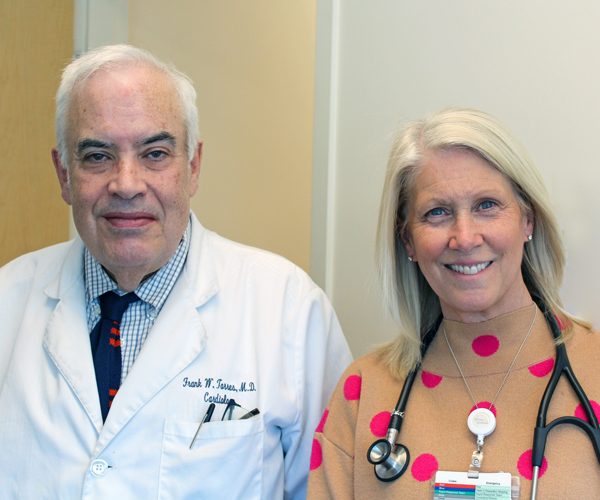Women and Heart Disease Risk: The Underdiagnosed, Undertreated, and Underappreciated Condition
When you think about all the movies and television shows in which someone has a heart attack, it’s almost exclusively men. The fact is, heart disease is the leading cause of death for women in the United States. In 2020, which is the last official data completed, the CDC reported over 314,000 women who died from heart disease—one in every five female deaths.
“That’s a very high number for a disease that can, for the most part, be managed with diet and exercise,” states Heide Chaney, Doctor of Nursing Practice in the Jefferson Healthcare Cardiology Clinic.
Why Are the Numbers So High?
Chaney explains that heart disease in women is understudied, underdiagnosed, undertreated, and underappreciated. One notable survey revealed that only about 56% of women were actually aware that heart disease was their number-one killer.
“More women are worried more about breast cancer than about having a heart attack, even though heart disease kills about six times as many women every year. I think this is because fewer women know someone who has had a heart attack. More women actually know someone else who has experienced breast cancer,” notes Chaney.
One reason might be that there is a later age onset for cardiovascular disease. The average age for a woman to have her first heart attack is 70, whereas the median age for breast cancer diagnosis is approximately 60-62.
Outside of the cancer-heart disease comparison, women often dismiss their heart disease symptoms. They think of it as a “man’s disease,” and therefore tend to minimize their experience. They may not bring it up with their primary care provider for fear of being seen as “overreacting.” Even if they do broach the subject, they are often shut down. This is a cycle that has long been in place but must be broken.
“Those symptoms are often brushed aside or they are attributed to stress or panic disorder or hypochondria. Unfortunately, women are treated differently than men in many instances,” explains Chaney.
Finally, there’s just less information about women and heart disease versus men and heart disease. Gender bias in medicine is a reality. Chaney is working alongside others to change that as well.
“Women should focus on and adopt healthy lifestyles early, and they should also make sure their provider is aware of this increased risk,” cautions Chaney.
Symptoms and Diagnosis
Traditional symptoms of heart attack—chest pain/pressure, shortness of breath, etc.—reflect more of the male experience. In fact, only approximately one in eight women actually report chest pressure, tightness, or aching. Symptoms women should be aware of include nausea, sweating, vomiting, or pain.
“That pain can be referred to other places in the body other than the chest. It can go to their neck, jaw, throat, abdomen, or their back,” says Chaney.
There’s also a difference in the diagnostic practices between men and women. Per Chaney, cardiac catheterization has been the “gold standard” for diagnosing heart attack. But, this test tends to look for blockages in large arteries. Since women are more likely than men to experience plaque buildup in the smaller arteries of the heart, this test might not be the most appropriate to diagnose heart disease in women. A cardiac CT or an MRI might be a more appropriate test.
“Medical providers are just now starting to really realize, and study, that the same test, the same medications, and the same procedures that have been used on men for centuries might not be the answer,” she adds.
Women’s Heart Disease Risk Factors
With most disease states, there are modifiable and non-modifiable risk factors. For example, you can’t really do anything about your genetic predisposition to heart disease. Yet, you can take steps to control high blood pressure, high cholesterol, obesity, stress, and smoking habits.
Another modifiable risk factor specific to women is gestational diabetes, which is a strong predictor of heart disease. “Women should focus on and adopt healthy lifestyles early, and they should also make sure their provider is aware of this increased risk,” cautions Chaney.
Women also develop certain risks after menopause, so it’s crucial to work with one’s primary care provider or gynecologist to understand the implications.
Heart Disease Prevention Tips
Women have the power to take charge of their heart health in many ways. Chaney recommends the following:
- Eat a healthy, balanced diet of unprocessed foods such as fruits, vegetables, whole grains, nuts. Avoid foods high in saturated fat, sugar, and salt.
- Stay hydrated with water and avoid dehydrating liquids such as energy drinks or sodas.
- Exercise regularly, aiming for 30 minutes per week of moderate-intensity activities, five days per week (at a minimum).
- Avoid tobacco at all costs, even if it is secondhand smoke exposure.
- Limit alcohol—or even better, abstain from it altogether.
- Find ways to reduce stress levels.
Finally, don’t be afraid to approach your healthcare professional with concerns. “I think more women should be coming forward and asking about heart disease,” urges Chaney. “They will be the ones who will present their own personal risks. Not every primary care provider, especially if you travel to different places or move to different areas, will know that history. Your family history is important. We can take a lot of steps to prevent heart disease if we just know the facts.”





